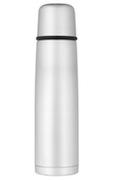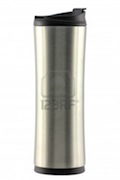Some metal containers such as the Nissan Thermos ones, even if 100 C water is filled inside, the container is still cold to the touch on the outside. It won't be even warm:

At the same time, some that look similar are so hot on the outside that holding it for a couple of seconds won't be possible:

Also, some teapot at Chinese restaurant or Vietnamese Restaurant, it can be boiling hot water inside, but the handle is also cold to the touch:

The question is, for the Nissan one and the ones at Chinese restaurants, if the metal part is all connected, from where the liquid is, to the part that the hand can touch, why isn't the handle or outside too hot to hold, but can be not much different from room temperature?
(the Nissan one is vacuum inside, but the metal container part is all part of a single piece.)

